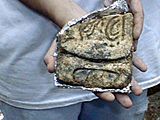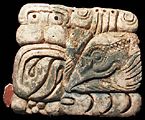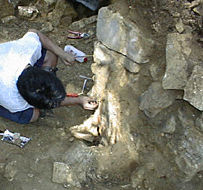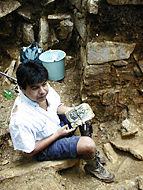
| 1997 1998 1999 2000 2001 Hilites | Page 1 - 2 - 3 - 4 - 5 |
STUCCO GLYPHS
| As previously noted, glyph blocks were found in fragments in the rubble below the interior jamb of the central support pier of Structure XIX. |
| It seems probable that when the stucco panel is completely restored, the original reading order of the text will be fully established. |
|
The following is a summary of their initial observations: Of the eleven and one-half glyph blocks recovered in the rubble in front of the interior jamb of Structure XIX, three of them are Calendar Round dates: 3 Ahaw 3 Yaxk'in; 6 Ahaw 13 Maun; 9 Ahaw 18 Sek.
A fourth glyph block is a period ending glyph, indicating that one of the dates occurs at the end of a tun or katun. The three dates span a period of exactly five tuns (1800 days), and the middle date is exactly equidistant between the earlier and the later dates. |

| Both Dr. David Stuart and Simon Martin agree that the period ending glyph is probably associated with the middle date, 6 Ahaw 13 Maun, which is the date of the 9.14.0.0.0 katun ending. |
|
The earlier date would then be 9.13.17.9.0 3 Ahaw 3 Yaxk'in, and the later date would be 9.14.2.9.0 9 Ahaw 18 Sek. Dr. David Stuart also noted a symmetry between these dates and another date, 11 Ahaw 18 Yax 9.13.2.9.0, from an unknown event in the life of K'inich Ahkal Mo' Nab III which is recorded on the jambs of Structure XVIII.
(Project epigrapher David Stuart has renamed this ruler based on a new reading of his name glyph. He was formerly known as Akul Anab III and before that Chaacal III.) The latest of the three dates from Structure XIX is the one katun anniversary of the earlier date from Structure XVIII, and the time period between this date and the earliest date from Structure XIX is exactly 15 tuns. The remaining middle date is the 9.14.0.0.0 katun ending. |
| Three of the glyph blocks (Element 1, Element 3, and Element 11) depict a bird (probably a heron) with a fish in its beak. No other examples of this glyph are known in the corpus of Maya hieroglyphs. |

|
|
The subject of one of these bird-eating fish glyphs is U Pakal K'inich "Shield of the Sun God". Three of the known examples of the name (or title) U Pakal K'inich were noted by Dr. David Stuart and Simon Martin. The first is from a brief inscription on a carved greenstone mask which was probably looted from Copan, Honduras. That inscription mentions the name U Pakal K'inich along with the Palenque emblem glyph. A second is from Naj Tunich, Drawing 29 (Andrea Stone, Images from the Underworld : Naj Tunich and the Tradition of Maya Cave Painting: p166). Here, U Pakal K'inich is the name of a lord of a polity called Ibil. The last example is from Tikal stela 17 in an uncertain context.
Two other glyph blocks, Element 5 and Element 6, refer to the name of GII or K'awil and are associated with a Ch'o-ko glyph, which, according to Dr. David Stuart, is translated as "the youth". The left collocation of Element 6, still out of order, is translated by Simon Martin as "Head Prince" or "heir to the throne". Based on the above preliminary observations, and considering the architectural and ceramic evidence (presented below), it is very likely that the text is a retrospective account of preaccession rituals. The subject of these rituals may be K'inich Ahkal Mo' Nab III; but if it is, he is using a previously unknown title. The subject of these rituals may also be a previously unknown king named U Pakal K'inich. |
THE INDIVIDUAL GLYPHS

| Click on the individual glyphs to see photographs and drawings. Please note that this is not the original order in which the hieroglyphs appeared. That awaits the fitting together of the matrix in our restoration lab under the direction of Alfonso Cruz, with funding from FAMSI. |


